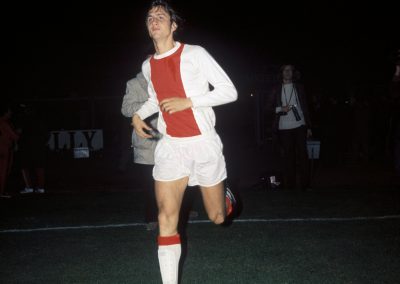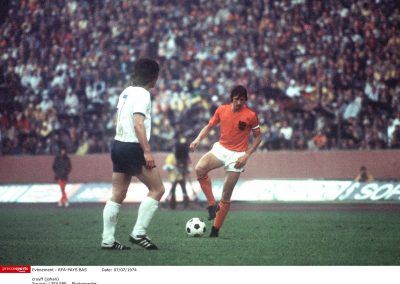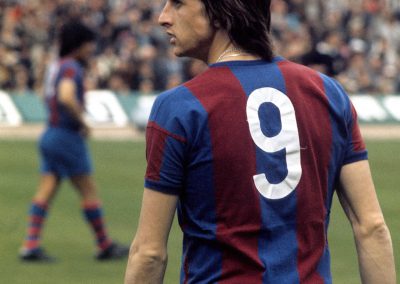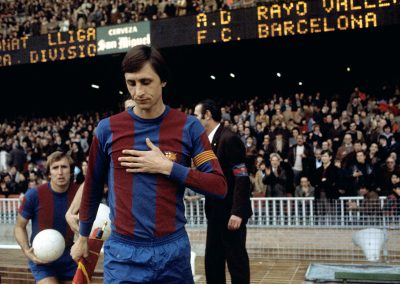Johan Cruyff – an appreciation
By Vince Cooper
If the oft-stated belief that a true great can only be defined as one who has been part of a World Cup winning team then Johan Cruyff is the exception that proves the rule. Indeed, the Dutch superstar only appeared in one finals, the 1974 event, spurning the opportunity to take part in 1978 (more of which later). But that one tournament, along with a glittering club career with Ajax and Barcelona made it clear that ‘Number 14’ is undoubtedly one of football’s true greats.
Johan Cruyff
8/1/1978 La Liga Football. Johan Cruyff in the Nou Camp. Photo: Offside / L’Equipe. Johan Cruyff im Stadion Camp Nou in Barcelona Fussball Spanien FC Barcelona
RFA-PAYS BAS
7/7/1974 Football World Cup 1974. West Germany v Holland (The Netherlands). Johan Cruyff. Photo: Offside / L’Equipe.
Johan Cruyff – FC Barcelona
Circa 1st October 1977 – Johan Cruyff of FC Barcelona – Photo: Offside / L’Equipe.
Born in a street just five minutes from the Ajax stadium Cruyff joined the club as a 10-year-old. His father’s death when Johan was just 12 is said to have spurred him to work even harder at the game and he quickly made his way through the ranks with the Amsterdam club, making his debut as a 17-year-old in November 1964 and scoring the only goal in a 3-1 defeat. By the start of the following season he was a first-team regular, bagging 25 goals in 23 games as Ajax claimed the Dutch title.
Ajax won the league in each of Cruyff’s first three full seasons and in two of those he claimed the Dutch Footballer of the Year award. An international debut came in September 1966, he scored in a 2-2 draw with Hungary. His second international came against Czechoslovakia and he was sent off. The referee stated in his report of the incident ‘Cruyff hit me’ a charge he vehemently denied. “I couldn’t believe it and at the FA hearing I protested my innocence,” he said later. “TV provided film of the match and the Disciplinary Committee ran this film through seven times before they were satisfied.
“Finally they said: ‘We cannot say that you did hit the referee but we have decided that you were unsporting.’ I was banned from playing in the national team for one year [he actually sat out 10 months]. Can you imagine how that made me feel?”
Under the leadership of the legendary Rinus Michels, Ajax became a major force on the European scene. The new style of ‘Total Football’ developed by Michels and with Cruyff as its leading exponent changed the face of football and culminated in a hat-trick of European Cup successes the middle one of which saw the brilliant ‘Nummer 14’ score twice in a 2-0 dismantling of Inter in 1972.
In his final European Cup success, over Juventus in Belgrade, he had what some have described as the ‘greatest 20 minutes of football ever seen’ tearing apart the tough Juve defence and culminating in Johnny Rep scoring the only goal.
The association of Cruyff with the number which has become his own started when, on making his comeback from injury in a match against PSV Eindhoven he found that Gerrie Muhren had taken his number nine jersey. Spurning other ‘normal’ numbers he decided to wear the 14, and continued to do so through most of the rest of his career, becoming the first player to regularly wear a number outside 1-11.
Having also played a huge part in bringing both the European Super Cup and the Intercontinental Cup to Amsterdam, Cruyff finally decided it was time to take his skills elsewhere. In the summer of 1973 the club agreed to allow him to move on. Ajax president Jaap van Praag struck a deal to sell him to Real Madrid but the player had his heart set on a move to Barcelona where Mentor Michels was in charge. The player’s skills had also been nurtured early in his career by English manager Vic Buckingham who had moved on to Barca and recommended that the Catalan club sign the player.
Cruyff later said: “I remember my move to Spain was quite controversial. People said I was going to a fascist country. The president of Ajax wanted to sell me to Real Madrid.
“I was born shortly after the war though, and was taught not to just accept anything.
“Barcelona weren’t at the same level as Madrid football-wise, but it was a challenge to play for a Catalan club. Barcelona was more than a club.”
Ajax and Barcelona eventually agreed a fee and the transfer was finalised but not until the Dutch federation had initially vetoed the move and forced Cruyff to remain in Amsterdam for the start of the 1973-74 season.
In his first season at the Nou Camp, Cruyff orchestrated a 5-1 over bitter rivals Real, helped his new team win their first La Liga crown since 1960 and was crowned European Footballer of the Year for the third time.
The summer of 1974 could have been the crowning moment of Cruyff’s playing career. With a supporting cast now including Johan Neeskens and Johnny Rep the Dutch were strongly fancied to win the World Cup in West Germany. Five wins in six matches (with the skipper scoring three times) set up a final encounter with the hosts.
In the 2nd minute of the final, a 15-man move culminated with Cruyff being brought down by Uli Hoeness. Neeskens slammed home the resulting penalty and the Dutch were on course. But the West Germans were nothing if not resilient and fought back. Berti Vogts did a great job closing Holland’s talisman down and goals from Breitner and Muller secured victory for the hosts.
Back in club football a combination of regular management changes and an average supporting cast saw Barcelona add only a Copa Del Rey to that La Liga success over the next four years and In 1978, at the age of 32, he signed a big-money deal to join Los Angeles Aztecs.
On the international scene 1978 looked to be an opportunity for Cruyff to add the missing element to his resume – a World Cup winners medal. He had played a major role in his country making the finals but then took no part in the main event. The reason for his no-show at the tournament in Argentina was for many years the subject of speculation. An argument with the Dutch governing body and objection to Argentina’s military junta were among the possible causes given for his absence but, after much speculation He finally came clean in 2008 when revealing that kidnap threats led him to stay away from South America.
In an interview with Catalan Radio Cruyff said; “You should know that I had problems at the end of my career as a player here and I don’t know if you know that someone put a rifle to my head and tied me up and tied up my wife in front of the children at our flat in Barcelona.
The attempt was foiled but Cruyff admitted that it changed his outlook.
“The children were going to school accompanied by police. The police slept in our house for three or four months. I was going to matches with a bodyguard,” he said.
“All these things change your point of view towards many things. There are moments in life in which there are other values.
“We wanted to stop this and be a little more sensible. It was the moment to leave football and I couldn’t play in the World Cup after this.”
Without their talisman the Dutch still made it to the final and the tantalising possibility remains that they may have captured the crown with Cruyff on board. There is little doubt that, at the age of 31, he was still in his footballing prime. With the likes of Ruud Krol, Johan Neeskens, Rob Rensenbrink and Johnny Rep also in the line-up there was already plenty for Argentina to be worried about. Would he have pushed them over the brink? We’ll never know.
But for Johan and family it was time for a new beginning so they headed off to California. After a pair of guest appearances for the New York Cosmos it appeared he would be joining NASL’s biggest franchise and taking Pele’s place in the Big Apple, But Cruyff had a change of heart and opted for the Los Angeles Aztecs. A single season on the West Coast (13 goals in 23 games and the NASL Player of the Year award) was followed by a campaign with the Washington Diplomats. When his new team ran into financial difficulties Cruyff remained but a combination of those money troubles and a dislike of the artificial surfaces many NASL matches were played on eventually led him to seek another move.
After turning out three times for FC Dordrecht in his homeland (as well as appearing in a tournament for Paris St Germain), and a period where he seemed set to sign for Leicester City, Cruyff eventually decided to return to Spain, signing for Second-tier Levante. Injuries, money troubles and a failure to win promotion blighted his spell with the Valencia club and before long he was looking elsewhere again.
So, in 1980 it was back to his spiritual and natural home with Cruyff signing a contract to become ‘technical advisor’ to coach Leo Beenhakker.
Despite suffering injuries Cruyff’s return inspired Back-to-back Eridivisie titles for ‘de Gondezonen’ but in 1983 the Amsterdam club decided not to offer him a new deal and then came another surprising move in a career which had already contained more than one.
Feyenoord had fallen on tough times and both Ajax and PSV had moved above them in the pecking order with others such as AZ Alkmaar threatening their place among the Dutch footballing elite. It was under these circumstances that Cruyff joined his hometown club’s bitterest rivals.
A one-year deal was agreed, despite protests from fans of the Rotterdam club. The season started with five wins from the first six games, seeming to calm the dissenters. However his return to the Olympic Stadium game seven ended in disaster. An 8-2 defeat brought all of the old doubts back to the surface but Cruyff remained adamant that his new team would take the title and so it proved. Playing alongside his future son-in-law, a 21-year-old Ruud Gullit, he led the team on a five month unbeaten run culminating in a 4-1 win over Ajax and clinching yet another title medal – his tenth all told and a cup success to go alongside it. A fifth Dutch Footballer of the Year award brought down the curtain on a glittering career which had lasted 20 years.
The honours won during his club career as a player bear the closest scrutiny but it was for more than just his prizes that Cruyff the player will be remembered. His on-field movement and fluidity was the true essence of ‘total football’ and he is perhaps the best example of a footballer who would in all probability have been as effective in any position with all-around skills that few, before or since, could match.
His influence off the pitch was also huge. Arguments with hierarchies at both club and international level peppered his career but Cruyff certainly helped footballers understand that their talents were what drove clubs and national teams to success. An argument with the Dutch federation over his refusal to wear adidas kit due to his agreement with Puma increased players’ knowledge of their marketing value.
We’ll discuss Cruyff’s influence as a coach and his roles later in life next time but, for now, let’s focus on Cruyff the player. The attached clip gives a brief insight into his talent and – truly – if you can find video of a footballer that encapsulates all that is good about the game better than this, I’d love to see it!
Johan Cruyff
8/1/1978 La Liga Football. Johan Cruyff in the Nou Camp. Photo: Offside / L’Equipe. Johan Cruyff im Stadion Camp Nou in Barcelona Fussball Spanien FC Barcelona
RFA-PAYS BAS
7/7/1974 Football World Cup 1974. West Germany v Holland (The Netherlands). Johan Cruyff. Photo: Offside / L’Equipe.
Johan Cruyff – FC Barcelona
Circa 1st October 1977 – Johan Cruyff of FC Barcelona – Photo: Offside / L’Equipe.





